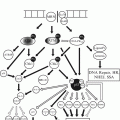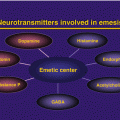Ι. Stem cell tumors
A. Intratubular germ cell neoplasia (in situ)
B. Seminoma
C. Spermatocytic seminoma
D. Embryonic carcinoma
E. Yolk sac tumor
F. Choriocarcinoma
G. Teratoma
H. Monodermal varieties
I. Mixed tumors
ΙΙ. Germ line cell tumors
A. Interstitial or Leydig cell tumor
B. Sertoli cells tumor
III. Mixed germ cell and germ line tumors
Gonadoblastoma
25.1.3 Clinical Evaluation-Diagnosis
Testicular tumors are generally developed in young men during their third to fourth decade of life. In 78 % of the cases, the disease appears in men aged 20–40 years, 20 % in men >40 years, and 2 % in boys under 18 years. Usually patients present with a painless, unilateral mass in the scrotum, found incidentally. In 20 % of cases the first symptom is pain in the scrotum or feeling of heaviness in the area, while up to 30 % of patients have local pain when palpating the testis. More rarely the disease is diagnosed by physical examination for accidental injury of the scrotum. Pain in loins occurs in a10 % of cases (due to retroperitoneal metastases). In a percentage of 10 % the tumor mimics orcheoepididymitis often resulting in delayed diagnosis, while rarely gynecomastia may occur, mostly in choriocarcinoma cases. Often the tumor can be accompanied by hydrocele and this why, if in doubt, a scrotum ultrasound should be prescribed. In case of metastases, the first manifestation of the disease may be shortness of breath or cough (pulmonary metastasis), skeletal pain (bone metastases), headache, neurological signs or symptoms in the central nervous system (brain metastases). The differential diagnosis of testicular cancer involves ruling out epidydimitis or orcheoepididymitis, hydrocele, spermatocele, haemocele, granulomatous orchitis, varicocele and epidermoid testis cyst or epididymis.
25.1.4 Staging
After the diagnosis, the surgical resection (radical orchectomy) and the histological characterization of the tumor, the complete staging of disease follows. A complete staging requires both imaging exams to ascertain if there are enlarged para-aortic, retroperitoneal and mediastinal lymph nodes or lesions of liver or lung, as well as the evaluation of tumor markers, beta- human chorionic gonadotropin and alpha – fetoprotein both preoperatively and postoperatively. Notably that beta – chorionic gonadotropin (β-hCG) increases in cases of non seminomatous tumors since rarely a seminoma contains syncytiotrophoblastic and cryptotrophoblast elements, while the alpha- fetoprotein increases only in case of non seminomatous tumors containing elements of embryonic-cell carcinoma or yolk sac tumor. The half-life for alpha – fetoprotein is 5–7 days and for beta – human chorionic gonadotropin is 2–3 days. Thus the detection of high levels after orchiectomy is indicative of residual disease. Brain CT and bone scans are performed only when clinically indicated. Based on these criteria, the disease is classified as stage I, II or III, as shown in Table 25.1. Stage I disease refers to cancer limited to the testis, stage II disease refers to the presence of enlarged subdiaphragmatic lymph nodes and stage III refers to disease that has spread to the diaphragm or parenchymal sites.
Table 25.1
AJCC-UICC TNM testicular cancer classification
Testicle (Τ) | II |
|---|---|
pTis | Intratubular, in situ |
pT1 | Testis and epididymis, without vascular/lymphatic invasion |
pT2 | Vascular/lymphatic invasion, extending through the tunica albuginea and tunica vaginalis |
pT3 | Invasion of spermatic cord |
pT4 | Scrotum invasion |
Retroperitoneal lymph nodes | |
Ν1 | <2 cm |
Ν2 | 2–5 cm |
Ν3 | >5 cm |
Metastases | |
Μ1a | Nonregional () nodal or pulmonary metastasis |
Μ1b | Distant metastasis other than to nonregional lymph nodes and lung |
Plasma biomarkers | |
S1 | LDH<1.5 N, HCG<5,000 IU/l AFP<1,000 ng/ml |
S2 | LDH 1.5–10 N, HCG 5.000–50.000 IU/l |
AFP 1,000–10.000 ng/ml | |
S3 | LDH >10 N, HCG >50.000 IU/l |
AFP>10.000 ng/ml | |
Stage | |
0 | pTisN0M0 Sx |
I | pT1-4 N0M0, S0-Sx |
IIA | pTany, N1 M0, S0-S1 |
IIB | pTany, N2 M0, S0-S1 |
IIC | pTany, N3 M0, S0-S1 |
IIIA | pTany, Nany M1a, S0-S1 |
IIIB | pTany, Nany M0, S2 |
pTany, Nany M1a, S2 | |
IIIC | pTany, Nany M0, S3 |
pTany, Nany M1a, S3 | |
pTany, Nany M1b, Sany | |
It is acknowledged that patients with stage II and III disease are a heterogeneous group with different prognosis and that the integration of tumor marker tests in this classification could provide better distinction between prognostic groups. One of the most important steps in this field was the international classification of the International Germ Cell Cancer Collaborative Group (IGCCCG). This group designated the relevant outcomes to each group of patients and has made the treatment approach more rational: Young patients who belong to low-risk group will take less aggressive therapy with emphasis on preventing toxicity from unnecessary treatments, while patients in high risk group should receive more toxic treatment, with a higher threshold of acceptance risks of late effects, in order to provide the best chances for long-term survival (Table 25.2).
Table 25.2
IGCCCG international classification
Non seminomas | Seminomas |
|---|---|
Good prognosis | |
Primary testicular tumor or retroperitoneal without non-pulmonary intestinal metastases and biomarkers S1 level | Any primary site without non-pulmonary intestinal metastases and any level of plasma biomarkers |
(56 %, 92 % 5-year survival) | (90 %, 86 % 5-year survival) |
Intermediate prognosis | |
Primary testicular or retroperitoneal tumor without non-pulmonary intestinal metastases and biomarkers S2 level | Any primary site with non-pulmonary intestinal metastases and any level of plasma biomarkers |
(26 %, 5-year survival 80 %) | (10 %, 73 % 5-year survival) |
Poor prognosis | |
Primary tumor in the mediastinum with pulmonary intestinal metastases or biomarker S3 level | None |
(16 %, 48 % 5-year survival) | |
25.1.5 Treatment
25.1.5.1 Orchiectomy
The surgical resection of the affected testicle is usually performed before any other therapeutic manipulation. Especially patients with rampant metastatic disease, which is life threatening, receive adjuvant chemotherapy followed by orchiectomy. Radical orchiectomy is performed through an inguinal intersection. Followed by the en block removal of the testis, along with the tunica and the spermatic cord up to the medial inguinal orifice. Patients with preoperatively negative plasma tumor markers test, and small, (probably benign) tumors, a statistical analysis based on quick core biopsies should be preceded to avoid an unnecessary orchiectomy and allow a smaller coherence with organ preservation.
25.1.5.2 Stage Ι Seminoma
The recurrence rate after orchectomy rises to 15–20 %, if not followed by adjuvant chemotherapy. Treatment options for stage I seminoma include surveillance, radiotherapy and chemotherapy.
The advantage of mere surveillance is the fact that 80 % of the patients will not be subjected to a treatment that might be eventually unnecessary, given that they would not relapse and therefore they could be spared the consequent toxicity. However, even in case of relapse, the cure rate remains high. On the other hand, surveillance is not only an intensive and long procedure but it also requires a high level of compliance from the patient’s side and entails feelings of stress and fear of relapse risk. In general, this method is suggested for stage I seminoma patients, with no evidence of risk factors (tumor size <4 cm and absence of rete infiltration).
Stay updated, free articles. Join our Telegram channel

Full access? Get Clinical Tree





